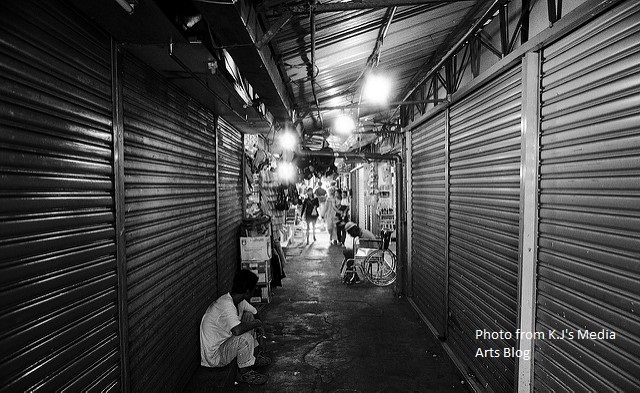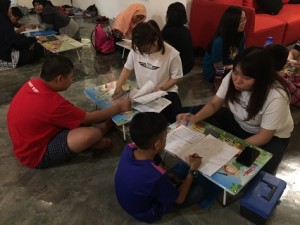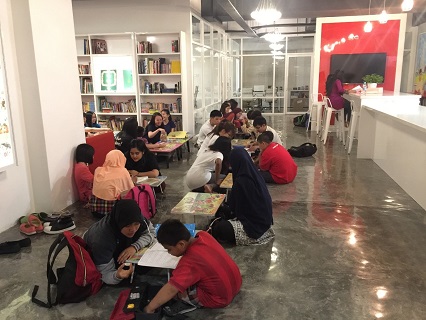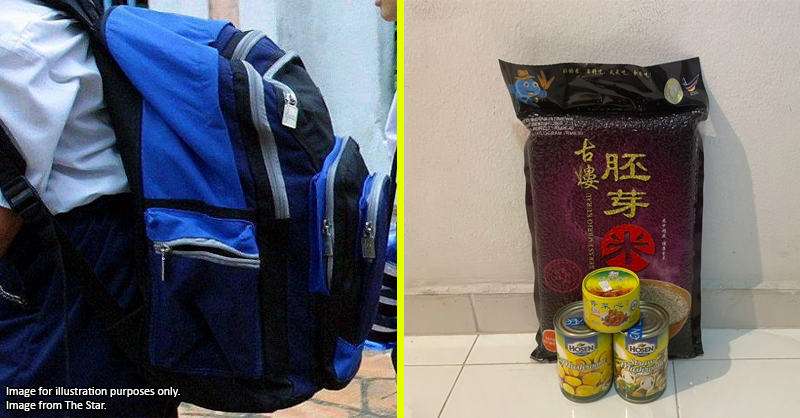5 humbling things I learned from spending a night with the children of Chow Kit

- 2.8KShares
- Facebook2.6K
- Twitter15
- LinkedIn31
- Email45
- WhatsApp118
In March, my university partnered together with Buku Jalanan Chow Kit to tutor children who couldn’t afford tuition. It was to be held every Friday night, from 8:30pm to 10:30pm. I volunteered along with 6 other students. Sounds really noble right?
Until I told my parents I’d be teaching in Chow Kit Road.
“Eh there alot of ah guas (transvestites) one.”
“Be careful or you’ll get robbed.”
“So many foreigners there. Safe anot?”
“Careful you don’t kena caught become prostitute.”

Really rude right? Yet in the corner of an advanced Kuala Lumpur, sits an undignified Chow Kit Road. A sore thumb sticking out with prostitution, drugs, and homelessness. It’s no wonder Malaysians don’t like that place lah.
But we forget that it’s home to children too! We were to tutor around 15 children no older than 12 years old. Most come from broken and low-income families that can’t afford to send them to costly tuition centers. Research has shown that poor children have a harder time accessing education, so no wonder they were in need of help.
We had to strictly follow 4 rules as volunteers:
- Always stay in pairs
- DON’T give out your phone number
- Actually, don’t even show em your phone
- DON’T take frontal photos of the children. Protect their identity.
With that down, about 10 of us (plus 2 university supervisors) crammed into the van for the night ride to Chow Kit. To be honest, I was prepared to teach in some dodgy dark lorong, half expecting Golem to jump out at me. After a 40 minute ride, the van stopped in a dimly lit side alley where we were ushered quickly into a building.
We stepped into a rickety lift, lit by flickering fluorescent lights. Horror movie worthy.

But when those doors opened, we were greeted by a surprising sight. The children of Chow Kit are about to flip my perceptions on its head.
1. WHOA. This place is lit!
The tuition center was provided by Institut Onn’ Jaafar. It was pretty spacious like a large living room, furnished with glossy cement floor panels and brightly lit. There was even a comfortable sofa section, with small tables arranged neatly on the ground for the session.


IOJ’s tuition center was air-conditioned and had squeaky clean floors. They had organized bookshelves lined up against the wall, home to colorful children books. The sofa section was furnished with soft colorful pillows. Carpets spread out in this area for children to read comfortably. There was even a spacious pantry with a wide counter top with clean running water. I’d even go as far as saying this place looked hipster. As for the toilets? Pristine with no sign of stink bombs.
Guess I won’t be finding any Golems here… but I was about to trip on some proverbial rocks…
2. The language barrier is REAL
I got to teach a chubby 11 year old Chinese boy, Ang*. When I first met him, he immediately asked if I could speak in Mandarin. Let’s just say my Mandarin is really rojak. I even had to Google Translate some words to Mandarin to strike conversations with Ang. However, as we progressed with his work, there were times that he couldn’t understand questions that were in Malay. He took a longer time to go through his work. Sometimes even guessing his way through.

Turns out, he wasn’t the only one. This became a problem as the children’s homework was often in English or Malay. Yet, most kids there prefer to converse in either Malay or Mandarin, causing a language barrier. Why? Most speak only one language at home. That doesn’t allow much room for practice.
Most of them don’t speak English in households. This *may* decrease their life opportunities as English is regarded as the international language. It’s everywhere: In daily communication, movies, books, and culture. Furthermore, some had to prepare for upcoming Primary School Achievement Test (UPSR) or Form Three Assessment (PT3).
But we have to note though, Mandarin has been quickly been on the rise. In 2013, the British Council ranked it as one of the top 10 most important languages to UK’s future… and seeing how China is quickly nudging US off as the world’s largest GDP, it’s also probably our turn to brush up on our mother tongue!
But even though we barely spoke the same language…
2 … it doesn’t mean they’re stupid or lazy.
It was time to get to the main event. Ang proudly brought out his math homework. “It’s my best subject!” he beamed in Mandarin. Sure enough, his exercise book had stars and ticks all over. As I flipped through, he’d point out his favourite chapters. When it was time to learn rounding off numbers, he was a quick learner. He solved equations faster than I had to calculate on my phone.

We have terrible misconceptions that affects how we treat under privileged children. Thinking that they’re all hyperactive, loud and rude because their family “doesn’t have time to teach them”. Though there were a few who got distracted easily, the rest focus well with one-on-one teaching. They’ll only pay attention if you do too.
What’s home like for these children then? Their households are often devoid of parents, struggling to earn pennies to simply afford a roof over their heads. Is that a reason to shun these children? To insult them from our high-privileged horses? Some parents are too poor to send their children to school. As of 2016, low-income households earn as little as RM900-1000 combined a month. After that, they gotta factor in paying rent, amenities, food and public transport. Feeling the heat already?
Once that’s done, the cost of uniforms, exercise books, stationery, pocket money, shoes etc roughly estimate up to RM310 a year per child?
Now imagine sending 2-3 children to school at once.

In this outcry, NGO tuition centers have stepped in to offer basic classes to aid reading, writing, calculations and art. As I looked around the room, some volunteers were solving puzzles, coloring books, using flash cards or reading picture books to the children. So no, Chow Kit children are no different in learning. Ya just gotta be patient in finding creative and effective ways to teach.
3. They often come with empty stomachs
The moment “masa rehat!” rang out, the children RAN FOR IT like the Hunger Games. It was 9pm, as nasi ayam percik and water was handed out by the supervisors. I sat with Ang, watching him eat.
“Where’s your food?” he looked at me with a mouthful of rice.
“I already ate at home before coming here” I smiled. Volunteers aren’t supposed to eat their food kan.
He paused “You’ve food at home? Did your mom make it?”
“Nah, I don’t stay with my parents.” I stayed in apartments near my university
His voice lowered “My dad doesn’t stay with me anymore too.”
Dei don’t do this to my heart la.

It’s no secret, poor families struggle to obtain nutritious food. How much can a peddler or odd-job parent make in a day? They’re wrestling to make ends meet, let alone afford proper meals that kids should have. As the price of whole food rises, they often settle for cheap, unhealthy, and unfulfilling snacks. As long you eat right? It has gotten so bad to the point that many soup kitchens have emerged in KL to feed the urban poor. Hence, the tuition center provides food halfway through to session to help children concentrate better into the night. The body needs proper nutrition to prevent fatigue.
You’re wondering how did these children even get to Chow Kit? Here’s one:
“Most of the city’s poor are those who migrate from small villages hoping to secure better employment opportunities, but they end up with low-paying jobs as they lack the required skills and experience.” – Munirah Hamid, PERTIWI Soup Kitchen Founder. Quote from The Malay Mail Online.
In contrast, most of us have visited cafes where we probably spent RM13+ on JUST COFFEE. Think about it.

After the break, I noticed Ang was more upbeat and focused despite it being almost 10pm. He was also sharper in solving trickier questions. Perhaps it’s innocence that causes them to appreciate little things, instead of being bitter about their situation. Something negative most adults would do. They haven’t seen the rest of the world to compare to. Maybe that’s why nasi ayam percik is the best part of their day.
4. “We’re all in this togetheeer!”
All children from the center were of various races and religion, but they were quick to mix around and make friends. They would share color pencils (Lord knows how precious those were) and even take turns using the flash cards. Even though the tuition center provided material, they don’t snatch or quarrel over it. Interesting hmmmm?
Eh when I wanted to borrow color pencils in primary school, my friend said “My mom said don’t share with people. After it’ll get lost or spoiled” SELFISH MUCH??

It’s was common for the children of Chow Kit to have troubled parents. Imagine drug addicts, prostitutes and the homeless – it’s a heavy topic kids don’t talk about. There are “less severe” circumstances like children of single parents, jobless households, or refugees. Ang’s dad left and remarried after, abandoning Yang and his mom to struggle on Chow Kit’s vicious streets. But like any good parent, they refuse to drag their children further into a bleak lifestyle. Though it’s late at night, they knowingly submit their kids to IOJ’s night tuition. Better education than loitering in god-knows-which unsafe street.
Here in the center, children share a close bond that probably stems from sharing similar problems and social classes with each other. Most don’t fit in at school. You’d expect greediness where resources are limited, but NOT in this classroom. It was humbling to see them readily share what they have to make sure everyone has enough. And as High School Musical would say:

5. They’re more selfless than the rest of us
Though they come from poorer backgrounds, they don’t hold on so tightly to what they have. For instance, everyone was given Kit Kats towards the end.
“Aiya, mine’s broken already” I sighed.
Instantly, a 6 year old girl beside me offered me her unbroken Kit Kat.

Broken Kit Kat still tastes the same, big deal meh? I finally realized though I was more privileged, I still found things to complain about. Whining about petty little things just because I was uncomfortable.
“Doesn’t this restaurant have air conditioning?”
“Why is my food so slow?”
“Ugh, why do I have to study this?
These children deal with far more than discomfort, yet they’re still the kindest souls I’ve met. Another incident happened while I was talking to the tuition’s supervisor. Remember I was tutoring Ang? She told me that he was a special one.
“He always asks to take home more food for his mom and his friends at school.” We think everyone can afford it, so what’s the use of sharing?

Yet instead of hoarding food, Ang proved that you don’t have to be rich to care. Heck, he’s not even earning. He’s got only one principle down: People are always more important than material things.
How many of us can prove the same?
It made me realise what a privileged life I was living
Soon it was 10:30pm, it was time for us and the children to go home. Some had chaperons waiting to take them back to homes. However downstairs, we saw a few adults waiting in the dim shadows of street lights. Almost hoping it’ll hide them from the city’s eye. I could barely see the faint outline of a big stocky woman, and soon learned that she was Ang’s mom!
My lecturer nudged me forward “Aunty, this is the student that taught your son today.”
I smiled at her, only to be replied with a harsh nod before she quickly ushered Ang away. He waved at me. He was bubbly whereas his mother was solemn.
“Bye bye, jie jie!” That was the last time I saw him.

That night, I felt a strange tugging at my heart. Because I’d go home tonight to sleep in an air-conditioned room with a bed all to myself. Probably sleep in the next morning. But at the back of my mind, I could only imagine these kids squeezing tightly into a single bed with their siblings. Sweating throughout the night under a single fan. Did they have to wake up early the next morning to help their parents earn money? I saw things differently now. I felt responsible for these under-privileged children. Be it donating or volunteering, I knew my difference in social class made it possible for me to give these children a better shot at life.
My RM20+ cafe adventures could wait. Chow Kit’s children needed meals ASAP.
No longer did I see them as rascals of the alleys. I saw children who were dealt a difficult hand of cards, but still pushed forward with life’s game. Educating children gives them a head start in life. As of 2011, UNICEF estimates that around 120,000 children in Malaysia don’t go to school. Challenges include complications in birth registrations, marginalized groups of urban and rural areas, and parents who fail to prove the legitimacy of their marriage.
Withholding education from children is not only a violation of children’s rights, but dooms them to the same poverty cycle of their parents. With low education qualifications, it’s tough to get a higher paying job to break free from poverty. Thus subjecting them to laborious jobs in poor health conditions. On a national scale, a study has revealed that the rise of uneducated children will stunt economic growth of developing countries.
The stakes of Malaysia’s next generation is high. Ready to reach out and make a difference for the children of Chow Kit? Here are a few foundations that you can get involved with.
Compelled to contribute? These are just few of many organizations that seek to improve the livelihood of children across Malaysia. Ran out of dating or hang out ideas? Time to give volunteering a shot! You’ll make many lives better through one selfless activity.
* Name changed to protect individual’s identity
- 2.8KShares
- Facebook2.6K
- Twitter15
- LinkedIn31
- Email45
- WhatsApp118



